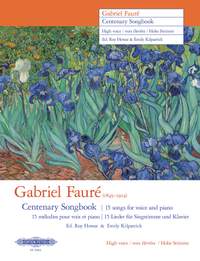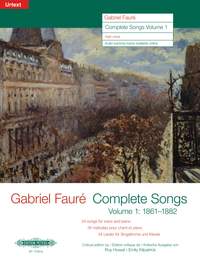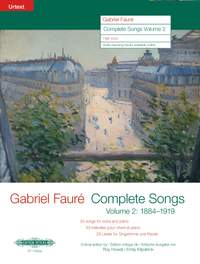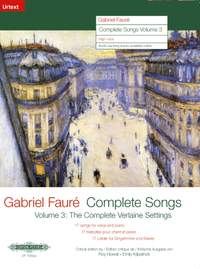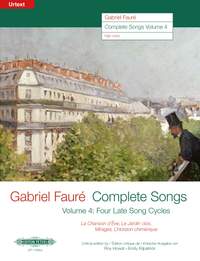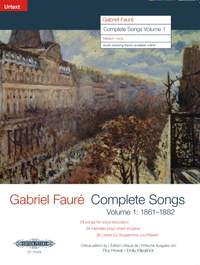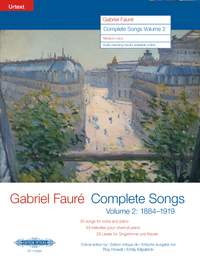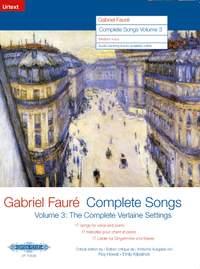Interview,
Roy Howat & Emily Kilpatrick on Fauré's vocal repertoire

Roy Howat and Emily Kilpatrick are the foremost experts on the vocal repertoire of Gabriel Fauré. They have spent years working together to create the four-volume critical edition Gabriel Fauré – Complete Songs, as well as the recent Gabriel Fauré Centenary Songbook: a celebratory edition containing fifteen of his most beautiful and popular songs. We asked Roy and Emily some questions about the composer, working together on the critical edition, and why his compositions are still so important today.
I firstly wanted to ask you about your interest in this composer: why Fauré? What do you enjoy about his work specifically?
He sounds like nobody else, with a marvellous intensity and tautness to his music, never a bar wasted or a predictable move. Historically he’s fascinating – born under the last French monarchy when Chopin and Schumann were still active, he was still composing in the early 1920s when Stravinsky and Schoenberg had become famous. So his hundred-plus songs are a true journey through musical history.
Can you tell me more about the new collection: why did you choose these particular songs to feature in the centenary edition?
We wanted to bring some of Fauré’s best-loved songs together with some less-known gems, such as the extracts from his late cycles. 'La lune blanche' and 'Mandoline' are tasters for the magnificent Verlaine cycles of the 1890s – one of the absolute peaks of the entire song repertoire. 'Mai' shows the innate inspiration and mastery he had developed before he was even out of his teens. We wanted to include a wide range of his poets, as well as one of his wordless Vocalises: composed as tests for the Paris Conservatoire, the vocalises were published for the first time in our 2013 Peters volume of Fauré’s Complete Vocalises. We’ve chosen the last of them to feature in our Centenary Volume, a short but concentrated gem of a piece dating from his vintage years.
You also created the complete edition together; what did you learn when undertaking the project?
How thoroughly Fauré understood poetry, and how thoroughly he tailored his musical language to each poet he set. He considered carefully how to communicate with performers, and would sometimes reword instructions or even rework musical details to try and clarify his meaning. It often leaves us with various ways of reading a passage or a song, and we increasingly saw that flexibility as an important element we wanted to convey in the edition. In compositional terms, we were also struck by how much thought he put into transitions – moving from one musical section to another. These are the passages that often show the most revision in the manuscripts (and where errors could creep in), even as he tried to convey his intention always to make transitions as smooth as possible. Manuscripts themselves are always fascinating documents: there is a long trail of candlewax down the back of the last page of La bonne chanson, for example, which suggests he was working on it late one night – a circumstance that explains some disasters in the original published score, which we managed to correct a century later! Other manuscripts show cigarette burns, doodles, little caricatures – all vividly attesting to his lively, creative mind, but also to the demands of his busy life. Among much else, it became clear that he was never against transposition of his songs, contrary to what we sometimes saw asserted in commentaries. Having seen some performers inhibited by those unsupported assertions, we considered it vital for the new edition to make the songs available to an appropriate range of voices, as Fauré demonstrably did during his lifetime.
I believe you studied hundreds of manuscripts and printed sources for the complete edition. What was the most interesting or surprising thing that you learned in that process?
You tested the editions internationally in masterclasses, workshops, seminars, concerts, and recordings, with the participation of professional singers, students, teachers, coaches, and specialists. How did this affect the final result?
Experienced performers and teachers can quickly pinpoint passages that seem problematic, and we wanted to be sure we addressed them all. A solution often emerged from an early source, for example a manuscript or early edition that had later been miscopied or misprinted, sometime in the course of producing different transpositions or collected volumes. Sometimes Fauré just forgot to write in obvious accidentals (all composers do), or we could see that his eye had jumped as he copied, and something went in the wrong place. It’s a delicate but vital part of editing, as well as being careful not to interfere with what might be startling but intended. To that end we listened carefully to what happened in workshops, masterclasses and performances, along with what professional colleagues observed – just as Fauré did in his time. Some willing performers also let us explore alternative versions from different sources in greater depth, helping us decide what was most useful to show on the musical page, avoiding clutter, and to ensure that any editorial guidance we offered was well directed and easy to navigate.
Why should singers learn repertoire by Fauré? What makes the songs so important? What do they teach us? What makes them enjoyable to sing?
The same reasons as they should learn Schubert and Schumann! He is one of the most important composers in the vocal repertoire – not just French repertoire, but song in general. His songs also offer the best training ground for French song – in particular they teach you how to appreciate, enunciate and communicate French poetry in song. As singers know, it’s quite a different art from singing Italian, German or English because of the way the French language and French poetry work. If you can sing Fauré, you’re well set up for Duparc, Debussy, Ravel and Poulenc. Beyond that, this is such a rich body of music, spanning and reflecting an extraordinary period of musical (and world) history – sixty years of songs that take us from Gounod all the way to Poulenc.
How do Faure’s songs compare to other French vocal music repertoire?
He was particularly friendly with Duparc, Chabrier and Chausson, and the differences are revealing. His musical thinking is less close to the German Lied than Duparc’s or Chausson’s, his syllabification less orthodox particularly in his earlier songs (though always brilliantly thought out). Chabrier’s songs, of extraordinary originality, deliberately aim at more of a vernacular, both in poetry and music, whereas Fauré can be heard coming more from Gounod, a source from which he eventually travelled a long way, with a very concise freshness of his own from the very outset. The brilliant way Debussy’s songs adorn and paint their poems contrasts with how Fauré tended to extract an overall mood for a song from key moments in a poem, the word painting often more subliminal in effect. (It’s one of his subtlest skills, once we spot it in operation.) Ravel, who was Fauré’s student, learned a lot of song- setting technique from Fauré’s songs (about which he wrote very admiringly in the 1920s), but the focus of his songs, in the wake of his idol Chabrier, lies more in storytelling, with a predilection for prose. Poulenc, setting mostly more avant-garde poetry, comes musically from his idols Chabrier and Debussy blended with Ravel’s dissonances; he professed not to like Fauré very much (all the modulation, he said, made him feel seasick), but nevertheless performed numerous Fauré songs with Pierre Bernac and Claire Croiza, as some very distinguished recordings attest.
What are your favourite lesser-known songs from the complete edition that you would recommend?
Who is the intended audience? Can beginners use the collection, or is it for more advanced singers?
We hope the ‘audience’ itself (who hear the songs performed from our edition) will be refreshed by what they hear, the edition itself being particularly aimed at students, teachers, and all performers, amateur or professional. Fauré songs are mostly not beginners’ material, as they already assume some skill. But they’re a wonderful way of acquiring the skills French repertoire demands. Songs like Mai and Lydia are marvellous introductions to his idiom; Les berceaux and Les roses d’Ispahan take you to the heart of his style, while some of the later songs (‘La lune blanche’, ‘Mandoline’, Arpège) offer real challenges not just to singers but to pianists – wonderful for developing ensemble skills. Clair de lune is a marvellous exercise in singing a poem over a fairly independent piano part that doesn’t ‘cradle’ the vocal line yet supports it. A song like Prison may look slow, but its text and harmonies move deceptively quickly – you have to be really on your toes, on top of every syllable and the pianist ready for each successive harmony, as they’re never what you expect. Fauré’s songs are equally superb training ground for singers and pianists, as the latter need to be able to respond to singers sympathetically, while keeping everything flowing and in time – Fauré was uncompromising about that!.
High Voice
Gabriel Fauré’s songs are a highlight of the French art song repertoire. To mark the centenary of the composer’s death, Edition Peters is proud to present the Gabriel Fauré Centenary Songbook: a celebratory edition containing 15 of his most beautiful and popular songs. This practical edition is based on the four-volume critical edition Gabriel Fauré – Complete Songs, edited by Roy Howat and Emily Kilpatrick. Short introductory texts to the pieces and translations of the poetic texts help to make this beautiful Romantic-Impressionist song repertoire accessible to all.
Available Format: Sheet Music
This is the first volume in a five-volume set of the complete songs and vocalises of Gabriel Fauré, the only complete critical edition. Based on the study of hundreds of manuscript and printed sources, Roy Howat and Emily Kilpatrick have tested the edition internationally in masterclasses, workshops, seminars, concerts and recordings, with the participation of professional singers, students, teachers, coaches and specialists. This first volume contains all songs written up to 1882, encompassing many of Fauré’s most well-known and loved songs, including Après un rêve, Le papillon et la fleur and Au bord de l’eau. The volume includes a preface in French, English and German, and translations into English and German of the original poetry.
Available Format: Sheet Music
Numbering more than 100 in total, and composed across a 60-year period, Gabriel Fauré’s songs form the single most influential contribution to the field of French art song. Despite their importance, the songs have long been riddled with misprints andinconsistencies. This first complete critical edition is based on study of hundreds of manuscript and printed sources, along with evidence and interpretative advice from artists who worked with Fauré. Above all, it is a practical edition, informed byextensive work with musicians in performances, masterclasses and workshops. This second volume comprises the songs of Fauré’s creative maturity, including popular favourites (Les Roses d’Ispahan, Clair de lune) alongside some lesser-known gems, together with his three vocal duets and the delightful four-voice Madrigal.
Available Format: Sheet Music
Fauré: Complete Songs Volume 3 (The Complete Verlaine Settings)
Edition Peters | High Voice and Piano
Gabriel Fauré’s seventeen settings of the poetry of Paul Verlaine mark the biggest single stylistic leap of his compositional career, and arguably one of the high points of the entire art song repertoire. The present edition contains the three individual settings Claire de lune, Spleen and Prison together with the op. 58 “Venetian” songs and the magnificient cycle La Bonne Chanson.
Available Format: Sheet Music
Award-winning and only complete critical edition of Gabriel Fauré’s works for voice and piano; Based on the study of hundreds of manuscript and printed sources; Tested internationally in masterclasses, workshops, seminars, concerts and recordings, with the participation of professional singers, students, teachers, coaches and specialists.
Available Format: Sheet Music
Medium/Low Voice
Gabriel Fauré’s songs are a highlight of the French art song repertoire. To mark the centenary of the composer’s death, Edition Peters is proud to present the Gabriel Fauré Centenary Songbook: a celebratory edition containing 15 of his most beautiful and popular songs. This practical edition is based on the four-volume critical edition Gabriel Fauré – Complete Songs, edited by Roy Howat and Emily Kilpatrick. Short introductory texts to the pieces and translations of the poetic texts help to make this beautiful Romantic-Impressionist song repertoire accessible to all.
Available Format: Sheet Music
This is the first volume in a five-volume set of the complete songs and vocalises of Gabriel Fauré, the only complete critical edition. Based on the study of hundreds of manuscript and printed sources, Roy Howat and Emily Kilpatrick have tested the edition internationally in masterclasses, workshops, seminars, concerts and recordings, with the participation of professional singers, students, teachers, coaches and specialists. This first volume contains all songs written up to 1882, encompassing many of Fauré’s most well-known and loved songs, including Après un rêve, Le papillon et la fleur and Au bord de l’eau. The volume includes a preface in French, English and German, and translations into English and German of the original poetry.
Available Format: Sheet Music
Numbering more than 100 in total, and composed across a 60-year period, Gabriel Fauré’s songs form the single most influential contribution to the field of French art song. Despite their importance, the songs have long been riddled with misprints andinconsistencies. This first complete critical edition is based on study of hundreds of manuscript and printed sources, along with evidence and interpretative advice from artists who worked with Fauré. Above all, it is a practical edition, informed byextensive work with musicians in performances, masterclasses and workshops. This second volume comprises the songs of Fauré’s creative maturity, including popular favourites (Les Roses d’Ispahan, Clair de lune) alongside some lesser-known gems, together with his three vocal duets and the delightful four-voice Madrigal.
Available Format: Sheet Music
Fauré: Complete Songs Volume 3 (The Complete Verlaine Settings)
Edition Peters | Medium Low Voice and Piano
Gabriel Fauré’s seventeen settings of the poetry of Paul Verlaine mark the biggest single stylistic leap of his compositional career, and arguably one of the high points of the entire art song repertoire. The present edition contains the threeindividual settings Claire de lune, Spleen and Prison together with the op. 58 “Venetian” songs and the magnificient cycle La Bonne Chanson.With its focus both practical and scholarly, this new Complete Edition of songs aims to encourage creative,confident and wellinformed performance. Founded on study of hundreds of manuscripts and printed sources, it has been tested internationally in masterclasses, workshops, seminars, concerts and recordings. In this it takes a lead from the composer, whoprepared his own editions on the basis fo performing experience. The edition also assimilates interpretative insights from musicians who worked with Fauré, as well as from his documented performing preferences.
Available Format: Sheet Music
Award-winning and only complete critical edition of Gabriel Fauré’s works for voice and piano; Based on the study of hundreds of manuscript and printed sources; Tested internationally in masterclasses, workshops, seminars, concerts and recordings, with the participation of professional singers, students, teachers, coaches and specialists.
Available Format: Sheet Music




